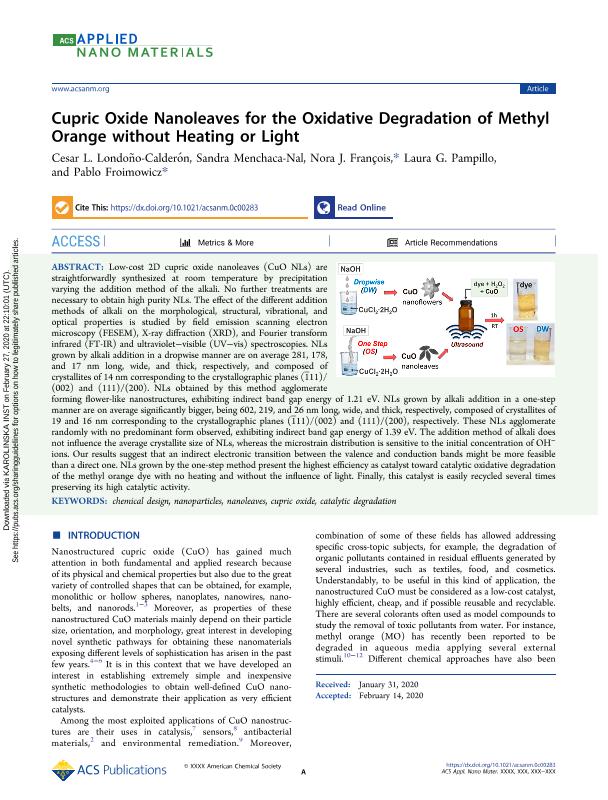Artículo
Cupric Oxide Nanoleaves for the Oxidative Degradation of Methyl Orange without Heating or Light
Londoño Calderon, Cesar Leandro ; Menchaca Nal, Sandra
; Menchaca Nal, Sandra ; Francois, Nora J.; Pampillo, Laura Gabriela; Froimowicz, Pablo
; Francois, Nora J.; Pampillo, Laura Gabriela; Froimowicz, Pablo
 ; Menchaca Nal, Sandra
; Menchaca Nal, Sandra ; Francois, Nora J.; Pampillo, Laura Gabriela; Froimowicz, Pablo
; Francois, Nora J.; Pampillo, Laura Gabriela; Froimowicz, Pablo
Fecha de publicación:
02/2020
Editorial:
American Chemical Society
Revista:
ACS Applied Nano Materials
ISSN:
2574-0970
Idioma:
Inglés
Tipo de recurso:
Artículo publicado
Clasificación temática:
Resumen
Low-cost 2D cupric oxide nanoleaves (CuO NLs) arestraightforwardly synthesized at room temperature by precipitationvarying the addition method of the alkali. No further treatments arenecessary to obtain high purity NLs. The effect of the different additionmethods of alkali on the morphological, structural, vibrational, andoptical properties is studied by field emission scanning electronmicroscopy (FESEM), X-ray diffraction (XRD), and Fourier transforminfrared (FT-IR) and ultraviolet−visible (UV−vis) spectroscopies. NLsgrown by alkali addition in a dropwise manner are on average 281, 178,and 17 nm long, wide, and thick, respectively, and composed ofcrystallites of 14 nm corresponding to the crystallographic planes (1̅11)/(002) and (111)/(200). NLs obtained by this method agglomerateforming flower-like nanostructures, exhibiting indirect band gap energy of 1.21 eV. NLs grown by alkali addition in a one-stepmanner are on average significantly bigger, being 602, 219, and 26 nm long, wide, and thick, respectively, composed of crystallites of19 and 16 nm corresponding to the crystallographic planes (1̅11)/(002) and (111)/(200), respectively. These NLs agglomeraterandomly with no predominant form observed, exhibiting indirect band gap energy of 1.39 eV. The addition method of alkali doesnot influence the average crystallite size of NLs, whereas the microstrain distribution is sensitive to the initial concentration of OH−ions. Our results suggest that an indirect electronic transition between the valence and conduction bands might be more feasiblethan a direct one. NLs grown by the one-step method present the highest efficiency as catalyst toward catalytic oxidative degradationof the methyl orange dye with no heating and without the influence of light. Finally, this catalyst is easily recycled several timespreserving its high catalytic activity.
Palabras clave:
CHEMICAL DESIGN
,
NANOPARTICLES
,
NANOLEAVES
,
CUPRIC OXIDE
,
CATALYTIC DEGRADATION
Archivos asociados
Licencia
Identificadores
Colecciones
Articulos(ITPN)
Articulos de INSTITUTO DE TECNOLOGIA EN POLIMEROS Y NANOTECNOLOGIA
Articulos de INSTITUTO DE TECNOLOGIA EN POLIMEROS Y NANOTECNOLOGIA
Citación
Londoño Calderon, Cesar Leandro; Menchaca Nal, Sandra; Francois, Nora J.; Pampillo, Laura Gabriela; Froimowicz, Pablo; Cupric Oxide Nanoleaves for the Oxidative Degradation of Methyl Orange without Heating or Light; American Chemical Society; ACS Applied Nano Materials; 3; 3; 2-2020; 2987-2996
Compartir
Altmétricas



